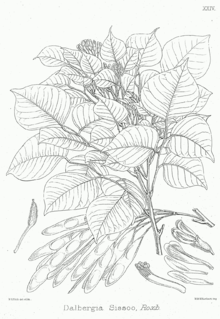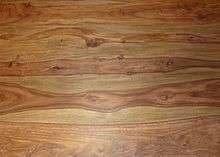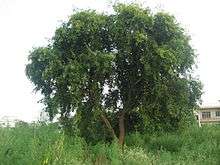Dalbergia sissoo
Dalbergia sissoo, known commonly as North Indian rosewood, is a fast-growing, hardy deciduous rosewood tree native to the Indian Subcontinent and Southern Iran. D. Sissoo is a large, crooked tree with long, leathery leaves and whitish or pink flowers.
| Dalbergia sissoo | |
|---|---|
 | |
| Scientific classification | |
| Kingdom: | Plantae |
| Clade: | Tracheophytes |
| Clade: | Angiosperms |
| Clade: | Eudicots |
| Clade: | Rosids |
| Order: | Fabales |
| Family: | Fabaceae |
| Genus: | Dalbergia |
| Species: | D. sissoo |
| Binomial name | |
| Dalbergia sissoo | |
| Synonyms[1] | |
| |
Description
D. sissoo is a medium to large deciduous tree with a light crown which reproduces by seeds and suckers.[2] It can grow up to a maximum of 25 m (82 ft) in height and 2 to 3 m (6 ft 7 in to 9 ft 10 in) in diameter, but is usually smaller. Trunks are often crooked when grown in the open. Leaves are leathery, alternate, pinnately compound and about 15 cm (5.9 in) long. Flowers are whitish to pink, fragrant, nearly sessile, up to 1.5 cm (0.59 in) long and in dense clusters 5–10 cm (2.0–3.9 in) in length. Pods are oblong, flat, thin, strap-like 4–8 cm (1.6–3.1 in) long, 1 cm (0.39 in) wide and light brown. They contain 1–5 flat bean-shaped seeds 8–10 mm (0.31–0.39 in) long. They have a long taproot and numerous surface roots which produce suckers. Young shoots are downy and drooping; established stems with light brown to dark gray bark to 2.5 cm (0.98 in) thick, shed in narrow strips; large upper branches support a spreading crown.
Distribution and habitat
D. Sissoo is native to the foothills of the Himalayas. It is primarily found growing along river banks below 900 metres (3,000 ft) elevation, but can range naturally up to 1,300 m (4,300 ft). The temperature in its native range averages 10–40 °C (50–104 °F), but varies from just below freezing to nearly 50 °C (122 °F). It can withstand average annual rainfall up to 2,000 millimetres (79 in) and droughts of 3–4 months. Soils range from pure sand and gravel to rich alluvium of river banks; shisham can grow in slightly saline soils. Seedlings are intolerant of shade.
Ecology
D. Sissoo is the larval food plant of the black rajah (Charaxes solon).
Uses
Timber

Shisham is the best known economic timber species of the rosewood genus sold internationally, but it is also used as fuel wood and for shade and shelter. After teak, it is the most important cultivated timber tree of Bihar, which is the largest producer of shisham timber in India. In Bihar, the tree is planted on roadsides, along canals and as a shade tree for tea plantations. It is also commonly planted in southern Indian cities like Bangalore as a street tree.
Sheesham is usually dried before being used in furniture manufacturing, a process commonly known as seasoning. Locally sheesham is left in wide open areas to dry under the sun for about six months. Commercially, sheesham is dried in closed chambers with hot air circulation for about seven to fifteen days, depending on weather conditions. The ideal moisture level is supposed to be 5-6% for thinner pieces and up to 11% for thicker ones, depending on use. Anything lower than this can cause sudden cracking of the final products.
Sheesham is among the finest cabinet and veneer timbers. It is the wood from which 'mridanga', the Rajasthani percussion instrument, is often made. In addition to musical instruments, it is used for plywood, agricultural tools, flooring, and as a bentwood, and for turning.
The heartwood is golden to dark brown; the sapwood is white to pale brownish white. The heartwood is durable (the specific gravity is 0.7 – 0.8) and is very resistant to fungi; but the sapwood is readily attacked by dry-wood termites and borers. Dalbergia sissoo is known to contain the neoflavonoid dalbergichromene in its stem-bark and heartwood.[3]
Fuel wood

The calorific value of both the sapwood and heartwood is 'excellent', being reported to be 4,908 kcal/kg and 5,181 kcal/kg respectively. As a fuel wood it is grown on a 10 to 15-year rotation. The tree has excellent coppicing ability, although a loss of vigor after two or three rotations has been reported. Shisham wood makes excellent charcoal for heating and cooking.
Teeth brushing
Traditionally, slender tree twigs (called datun) are first chewed as a toothbrush and then split as a tongue cleaner.[4] This practise has been in use in Pakistan, Africa, and the Middle East for centuries. In India, sheesham have been used in Siddha medicine system for skin disorders and stomach related issues. Many of India's 80% rural population still start their day with the teeth cleaning twig either with Salvadora persica or Azadirachta indica. In other parts of the world sheesham twigs are still collected and sold in markets for this use in rural areas.
Pesticide
Ethanolic extract of the fruits of Dalbergia sissoo exhibited molluscicide effect against eggs of the freshwater snail Biomphalaria pfeifferi.[5]
Construction
The juice of this plant is a potent ingredient for a mixture of wall plaster, according to the Samarāṅgaṇa Sūtradhāra, which is a Sanskrit treatise dealing with Śilpaśāstra (Hindu science of art and construction).[6]
Cultivation
Propagation takes place most commonly by root suckers and also by seeds. The seeds remain viable for only a few months. Seeds should be soaked in water for 48 hours before sowing and 60% – 80% germination can be expected in 1–3 weeks. Seedlings require partial sun or full sun.
Local names
Common names for D. sissoo are sisu, tahli or tali, and also irugudujava. Indian common names are biradi, and sisau. Pakistani common names are 'sheesham' and 'tahli' in Punjab. In Afghanistan its name is shewa, and in Persian, it is called jag. Dalbergia sissoo is the state tree of India's Punjab state and the provincial tree of Pakistan's Punjab province.
The wood of D. sissoo is known as sheesham or shisham and is an important commercial timber.[7]
See also
References
| Wikimedia Commons has media related to Dalbergia sissoo. |
- The Plant List: A Working List of All Plant Species, retrieved 12 December 2015
- Orwa, C. "Dalbergia sissoo" (PDF). Agroforestry database. Retrieved 25 December 2016.
- S. K. Mukerjee; T. Saroja & T. R. Seshadri (1971). "Dalbergichromene : a new neoflavonoid from stem-bark and heartwood of Dalbergia sissoo". Tetrahedron. 27 (4): 799–803. doi:10.1016/S0040-4020(01)92474-3.
- "Make A Neem Toothbrush (Neem Tree Home Remedies)". Discover Neem. Birgit Bradtke. Retrieved 16 July 2013.
- Adenusi A. A. & Odaibo A. B. (2009). "Effects of varying concentrations of the crude aqueous and ethanolic". African Journal of Traditional, Complementary and Alternative medicines 6(2). abstract, PDF.
- Nardi, Isabella (2007). The Theory of Citrasutras in Indian Painting. Routledge. p. 121. ISBN 1134165234.
- Tudge, Colin (2005). The Tree. New York: Random House. p. 182. ISBN 978-0-307-39539-9.